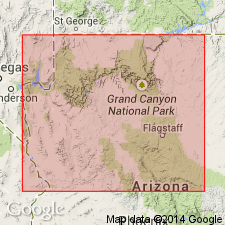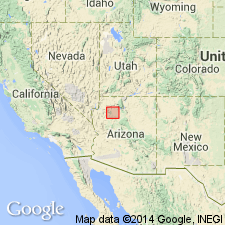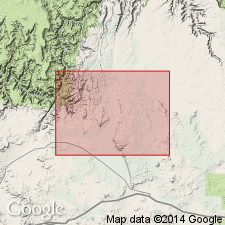
- Usage in publication:
-
- Robbers Roost gravel
- Modifications:
-
- Named
- Dominant lithology:
-
- Gravel
- AAPG geologic province:
-
- Plateau sedimentary province
Koons, Donaldson, 1948, Geology of the eastern Hualpai Reservation: Plateau, v. 20, no. 4, p. 53-60.
Summary:
Named for mesa located about 15 mi northeast of Peach Springs in western Coconino Co, AZ, Plateau sedimentary province. [Name actually proposed in Koons (1948, Science, v. 107, p. 475-476), however, there is little discussion of unit.] No type locality designated. Occurs in area of Blue Mountain and Robbers Roost and midway between Robbers Roost and Frazier Wells. Consists of locally derived pebbles composed of sandstone resembling Coconino sandstone and Toroweap and Kaibab formations, as well as limestone fragments ranging from 1 in to 2 ft in diameter. Occurs as alluvial or talus cones at bases of steep slopes or cliffs. Unconformably overlies pre-Quaternary units. Indicated by author to be older than Blue Mountain gravel (new). Geologic map. Quaternary age.
Source: GNU records (USGS DDS-6; Denver GNULEX).

- Usage in publication:
-
- Robbers Roost Gravel
- Modifications:
-
- Revised
- AAPG geologic province:
-
- Plateau sedimentary province
Summary:
Author previously indicated (Koons, 1948) that Robbers Roost was older than newly named Blue Mountain gravel. Footnote (p.100) states that deposits at Blue Mountain, Coconino Co, AZ, Plateau sedimentary province, are here considered to be Frazier Well Gravel. Robbers Roost deposits found in Babylon basin northeast of Blue Mountain and in a long relatively narrow exposure 5 mi west of the Frazier Well [geographic]. Deposits are equivalent in age to or later than faulting along southern branches of Toroweap fault; how much later cannot be determined. Assigned Quaternary age on geologic map (fig. 2).
Source: GNU records (USGS DDS-6; Denver GNULEX).

- Usage in publication:
-
- Robbers Roost Gravel*
- Modifications:
-
- Age modified
- Mapped 1:48k
- AAPG geologic province:
-
- Plateau sedimentary province
Summary:
Represents oldest Cenozoic deposit in map area. Occurs in paleovalleys located on high ridge east of Diamond Creek (center of map area) and in valley southeast of headwaters of Diamond Creek, Coconino Co, northwest AZ, Plateau sedimentary province. Gravels consist of consolidated, rounded to subrounded and angular pebbles and boulders, up to 2 ft in diameter, of Coconino Sandstone and Toroweap and Kaibab Formations. Maximum thickness is 200 ft. Deposits are considered to be Paleocene and Eocene age because stratigraphic position is apparently below gravels that contain Eocene gastropods a few miles east of map area (Young, 1985, Tectonic Geomorphology, p. 261-278). Contemporaneous or partly contemporaneous with Frazier Well Gravel and unnamed fanglomerate and undifferentiated gravels; unconformably overlies Lower Permian rocks.
Source: GNU records (USGS DDS-6; Denver GNULEX).
For more information, please contact Nancy Stamm, Geologic Names Committee Secretary.
Asterisk (*) indicates published by U.S. Geological Survey authors.
"No current usage" (†) implies that a name has been abandoned or has fallen into disuse. Former usage and, if known, replacement name given in parentheses ( ).
Slash (/) indicates name conflicts with nomenclatural guidelines (CSN, 1933; ACSN, 1961, 1970; NACSN, 1983, 2005, 2021). May be explained within brackets ([ ]).

